Crouch, bind, set: Eir Sport rugby team packs down for Pro14 season
Less than three weeks after serving as host broadcaster for the delayed Guinness Pro14 2020 rugby final at the Aviva Stadium in Dublin, the Eir Sport production team is preparing for the start of the new season this Friday with holders Leinster returning to their home RDS ground to take on the Dragons.
Eir Sport OB and studio director Jamil Abubakar and head of production Chris Blake spoke to SVG Europe about the challenges involved in broadcasting the condensed finish to the 2019-2020 season after a five-month layoff due to COVID-19, and the necessity to pivot quickly in order to go back on air for the 2020-2021 season this weekend.
Pro14 is the professional club championship featuring teams from Ireland, Italy, Scotland, South Africa and Wales. The final matches of the 2020 season featuring Irish teams were condensed into four weeks in August and September, with all fixtures held at the spacious 52,000 seat Aviva Stadium.
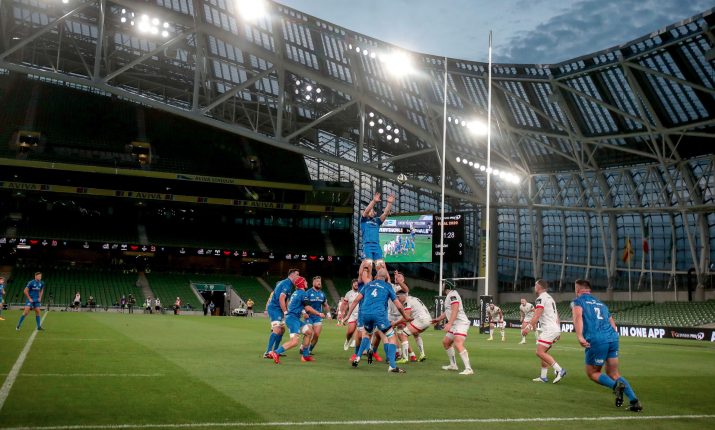
Leinster vs Ulster in the Pro14 final on 12 September at the Aviva Stadium in Dublin. ©INPHO/Billy Stickland
Eir Sport took the helm as host broadcaster for the final on 12 September along with OB facilities partner TVM, providing the live world feed for Premier Sports in the UK, DAZN for Austria, Canada, Germany, Italy and Switzerland, Sky Sports New Zealand, Super Sport South Africa, ESPN+ for the USA and live on Rugby Pass TV for Asia and Australia.
Outside centre Garry Ringrose captained Leinster for the first time as the province, with a straight 17 wins for the season, overcame Ulster 27-5 to seal the competition’s first three-in-a-row run of victories.
The Guinness Pro14 will break new ground as it introduces prime-time Monday Night Rugby to its schedule for the 2020/21 season. The first Monday night game will occur in Round 3 when Munster host Cardiff Blues at Thomond Park on 26 October as the tournament enters the week day prime-time market with a 20:15 kick-off slot.
In total, 14 Monday night fixtures will take place between Rounds 3 and 8 with scheduling aimed at preventing direct clashes with the extended international calendar.
With the finale of the Guinness Six Nations and the Autumn Nations Cup taking place from October through to early December, the majority of Pro14 fixtures during this time will take place on Sundays and Mondays. Where possible, Monday night fixtures have been set across two time slots of 18:00 and 20:15 (both UK/IRE).
Rounds 9, 10 and 11 of the tournament will feature the derby matches across the UK, Ireland (where they are known as ‘interpros’) and Italy and the scheduling for those games will occur in due course.
“This is our third year of a three-year deal covering the Pro14 in the Republic of Ireland,” said Blake. “We have exclusive rights to nearly all games, and have sub-license agreement with [Irish-language channel] TG4 to produce the Connacht games and some other games for Irish-language purposes only.
“TG4 is host broadcaster for all Connacht home games, and then as part of the package they’re also able to show Leinster and Munster games against Welsh opposition, home and away, and also the final.
“Premier Sports have rights in the UK exclusively, but again BBC Wales and S4C have some sub-licensing rights. It’s covered by DAZN in Italy through a production company, and by Super Sport in South Africa. These are the main broadcasters involved in discussions and then Pro14 has another couple of OTT partners for other areas.”
Let’s go back to when everything stopped in March. As it turned out you had a long five-month layoff and then had to quickly put a plan in place when it looked like the go-ahead would be given to restart the Pro14 season?
Chris Blake: “Yes the conversation ceased from March to May, when we were all in complete lockdown, not knowing what the future held. Then from late May conversations re-ignited about getting the season back up and running. I think the Bundesliga was probably the lead for all sports, to see that it could be done and how it could be done.
“There were many discussions but eventually it was felt best to allow an off-season to happen from June to August, coming back to play in mid-August. It was decided the best idea was to just play high value matches [such as Leinster v Munster or Edinburgh v Glasgow] every week and condense it into a four-week window. And as it turned out we ended up getting four weekends of interpro games, which was huge for us – especially as three of the four Irish provinces got into the knockout stages.
“Once that started we quite quickly turned to production mode regarding what it would look like and how it would be done. That came with quite a lot of challenges out of our control. Obviously the IRFU runs the Irish provinces and we were using the Aviva Stadium, so it had to go through many layers before it really got to us, and what we would be allowed to do.
“In fact everything went brilliantly and I must speak very highly of the Aviva, the IRFU and our
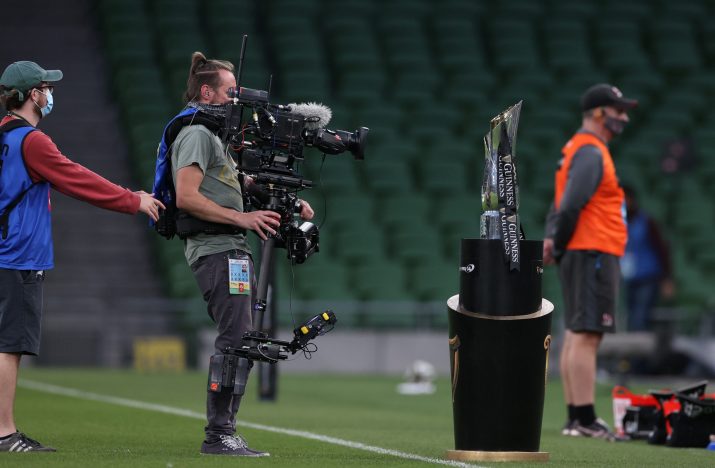
Steadicam operator and assist at the final. ©INPHO/Billy Stickland
broadcast partner TVM OB. But the biggest challenge was numbers: we just didn’t know how many would be allowed into the ground. In fact, the government made an announcement of further restrictions to numbers allowed in stadiums just five days before the first game which required us to reduce our numbers for Leinster v Munster game from close to 50 to below 40. That was our biggest challenge.
“Thankfully we have a very good relationship with Premier, the other lead broadcaster, so we were able to take a unified approach to the IRFU and Pro14 about how many bodies we genuinely and essentially needed. We were able to get past that bridge and then it got a little bit easier once we had done the first game.
“Fear is probably not the right word, but we were all extremely conscious that that first game at the Avivia was massive for us as broadcasters, for Pro14 as a competition, and also for the IRFU with the future in mind, considering how to run things safely with a view to trying to bringing fans back. There was a lot of pressure on that first game to do everything right.
“We were quite keen to host all the games at the Aviva, with double-headers. We felt we would be able to guarantee the product on our channel but also we felt that it would be best to have two games in one day. But they had to sanitise the pitch and the stadium between matches, meaning they had to split them into different days.
“This created a new problem — which thankfully didn’t become a problem! Because TG4 are host broadcaster for Connacht home games, and Premier Sports are host for the Ulster games, it meant they would have to be host broadcaster for their respective home games in the Aviva. We had to engage quickly with them on how that would work as we have different outside broadcasters: we use TVM while Premier and TG4 use NEP.
“That was probably the biggest hurdle for myself and Jamil, just making sure we could do all of that safely and securely with us getting in on a Saturday and getting out, and the others coming in on a Sunday. Thankfully it was relatively simple in the Aviva as it’s a pre-cabled stadium. If you were looking at the RDS it’s probably not do-able, realistically.
“So it was very much a collaborative effort to get that opening weekend done, with site visits, knowing what could be used and what cables could be touched and so on. Once we got through that first weekend we all had that inner realisation that what we were doing worked, was safe and wasn’t too badly impacted by the lack of numbers.”
Jamil Abubakar: “It’s a strange one, because normally you’re just not worried about the stadium: you can stay on your Camera 1 wide shot. But the first weekend was tough when we learned five days out that we had to limit camera crew.
“Losing the high-behind, which obviously as a director is vitally important in a rugby game, was something I found troubling. As the government guidelines came down with restrictions about having bodies on the pitch, that made me reel back what I wanted to do.
“Keeping the fans at home in mind I thought people just want to see a clean game of rugby; they’re delighted to see the teams back. So I forgot about trying to do gimmicky things and just concentrated on the game as best I could with what we had. So as the weeks went on we were allowed have more bodies on the pitch so were able to up the spec slightly.
“What can we do with camera positions? Things like your teams-out shot – that wasn’t really possible. But having seen TG4 use a locked-off mini cam above the tunnel, we then used a mini cam, remote controlled in that position. I then realised for the Leinster vs Munster semi final that we could put a box lens camera in a position right above the tunnel. You would never be able to do that on a ‘normal’ match day as there are fans in the way.
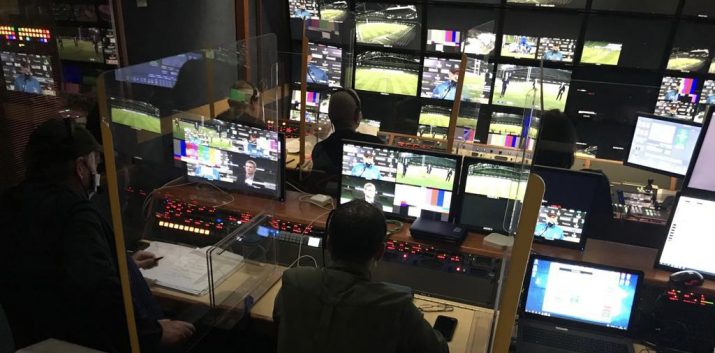
Screen-separated production area inside TVM’s OB8 for the Pro14 final
“But it turned out to be one of the best camera positions we’ve ever had in the Aviva. We could get nice and tight and it had the full range of the pitch – a lovely shot. Little things like that were important to give people at home something a little different. Subtle differences.
“We used TVM’s biggest truck [OB8], which we wouldn’t normally have to do. It has all the screens and social distancing in the truck and it’s all sterilised before you go in. You’re not allowed in the truck until the vision supervisor says that everything is clean.
“I directed and vision mixed every game myself, up until the final, when I decided I needed a vision mixer. We had to worry a lot more about what was going on for the world feed. Obviously we are doing our own programme and then we have to provide the world feed for everybody as well.
“We wanted to give the world feed what it deserved as it was the final – especially post-match, for the Leinster trophy presentation and the dejected Ulster players. It was great to have someone keep an eye on that, making sure what was going out was great value for the product, giving it what it deserved.
“For the final we did get our Steadicam and Steadicam assist PCR tested, so they could have more access and actually get on the pitch. Until the final, the Steadicam was only able to operate within a small area beside the nearside 22-metre line. But because he was on the pitch we were able to give it just a little more of a feeling that we were close to the players.
“It was just very strange that there was no one there for a final, and the way the trophy presentation took place … it was weird.”
Chris Blake: “For all of our other games we were the sole broadcaster allowed in. For the final the add-ons had to be included for Premier Sports and TG4. They had 20 to 23 bodies each allowed in for that one-off, so there was a restriction on us bringing in additional bodies.
“We wanted an additional radio and beauty cam that we had to just forego, in order to play as team members. We had to just prioritise that the match coverage was as good as it could possibly be, and accept that the trophy presentation was going to be weird. There’s no other word for it!
“We did the add-on for the final last year, in wonderful pre-COVID times in Glasgow, and we were actually able to do more in-game coverage than we could have if we were the host. In other words you would have two separate trucks, one doing your programme and one doing the world feed – and obviously that’s not applicable at this time. As host broadcaster you are somewhat restricted in what you can do in-game without damaging what goes out on the world.”
What about crowd noise – what was the approach taken? The crowd noise in rugby stadiums is very different to football.
Jamil Abubakar: “We waited until the Bundesliga started, and then we looked at the Southern hemisphere as rugby came back in Australia and New Zealand. We wanted to get a feel for it.
“We did a couple of dummy runs in our studio, with one of our assistant producers trawling through Leinster v Munster last time they played. We took a generic bed of sound and then a couple of layers of more excited crowd sounds. We got those three as basic beds and then went looking for Leinster and Munster chants, silence for penalty kicks – bits and pieces like that.
“We got it all together and put together in the studio with our commentator Connor Morris doing a dummy run, running it mute and then with our own beds, to get a feel for it. I actually think I mixed the audio myself on that!
“When we decided ‘yes, that’s what we’ll do’ we spoke to TVM, and sent on the beds. We were in
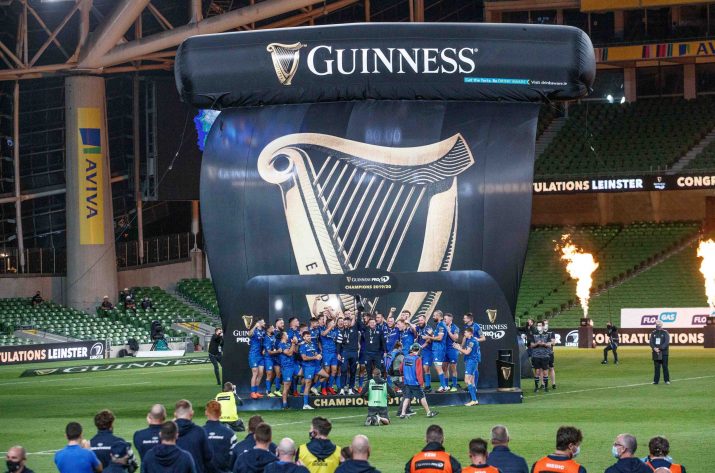
Leinster lift the Guinness Pro14 trophy. ©INPHO/James Crombie
discussion with Pro14 as well, trying to get some actual beds from them. They came back with hundreds of ambient rugby sound effects, so we did a mix and delivered it to TVM.
“All of the broadcast partners agreed that the product was better using artificial sound. It was left to each individual broadcaster as to the level and layers of sounds they wanted to add to the production.
“When it was agreed that all the host broadcasters would add ambient sound, it was then that Eir Sport added things like the chants, particularly in ‘dead-space’ situations like the time it takes from the referee’s whistle for a penalty kick to the kick being taken and the players walking up the pitch for the line-out.
“We were lucky that sound supervisor Darius McGann from TVM took it on himself to produce it as well as doing the normal mix – and he did a smashing job. Otherwise we would have had to bring in an additional sound producer.”
Chris Blake: “We were really trying to make it sound familiar to people at home. Not to interfere with the product, but to have it there without really noticing it, in the best possible way.
“We knew it was a release for people, so we wanted them to forget about COVID for those two hours. We wanted them to hear the crowd noise and think, ‘this is normal’.”
“Thankfully we went through this process early, because it’s almost impossible to find rugby match sound where the ref mic is not embedded. When you’re watching a rugby match, typically you only have about eight seconds where you don’t hear a whistle or the ref saying ‘roll away’ or ‘use it’.
“We were grabbing four seconds at a time and trying to combine all those pieces! And you don’t want the sound to not match the pictures.
“You’re trying to show the match without noticing the empty stands. The NFL does it particularly well: they’ve such eagle-eyed views you have no idea it’s an empty stadium. We knew it was a release for people, so we wanted them to forget about COVID for those two hours. We wanted them to hear the crowd noise and think, ‘this is normal’.”
So now a new Pro14 season is upon us. No fans — and back in the RDS on Friday evening for the first time.
Jamil Abubakar: “Again it just comes back to the red zones, blue zones and pink zones. Obviously we haven’t been to the RDS, so it will be a little bit different. Where can we go to set up positions for team arrivals, things like that. Otherwise we’re all lucky that last season’s final was less than three weeks ago and it’s all still in my head regarding what needs to be done. I’m just looking forward to it, to be honest. It will be nice to be back to the RDS.
Chris Blake: “There’s nothing glaring that’s harder to do at the smaller venues than it is at the Aviva – bar things like arrivals and teams-out, which are going to be harder to cover, if we can cover them at all in the traditional sense. We’re going to have to be safe and careful on match one in each venue, because we need to learn.
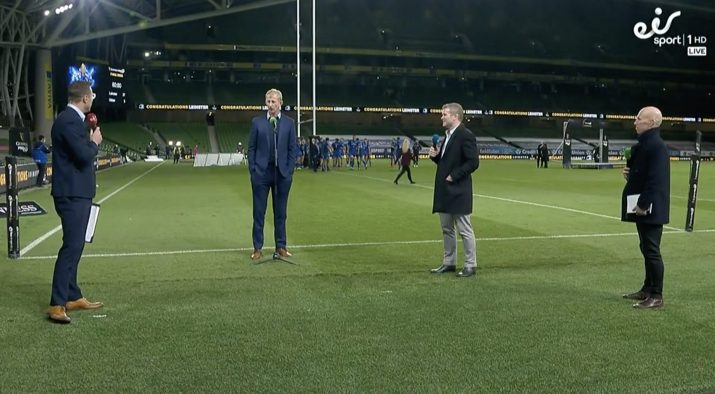
Post-match analysis: (left to right) Eir Sport presenter Tommy Bowe interviews Leinster head coach Leo Cullen, accompanied by ex-Irish rugby internationals Gordon D’Arcy and Peter Stringer
“We’re going to find out what works and what doesn’t. Every game at the Aviva was huge, it was interpro and the biggest thing on TV that day. We’re aware that although the interest is still there for the Friday evening re-start it’s not a knockout game.
“We’ll be setting a new narrative. Now we need to settle in and show that this is normal: it’s a new season and this is what it’s going to look like, with new talking points and new stories. And pretty much trying to avoid talking COVID, at all. Trying to just get on with it, from a viewer’s perspective, adding layers as we go.
“We want Friday night to be escapism for rugby fans. We are very privileged to be entrusted to broadcast these games to people at home. We’re very lucky to be there.
“Again I just want to single out TVM, who have been exemplary. Their professionalism and detail has been incredible.
“There was a lot of fear, whether people wanted to say it or not, about sitting in a truck for six to eight hours with other people after six months of being told to socially distance. But you couldn’t have felt safer with TVM; they had gone through everything. They made it very easy to go back to that environment and for us to focus on the job at hand.”
The 2020-2021 Guinness Pro14 season kicks off Friday 2 October with Zebre vs Cardiff Blues at Stadio Sergio Lanfanchi in Parma, followed by Leinster vs Dragons at the RDS Arena in Dublin
